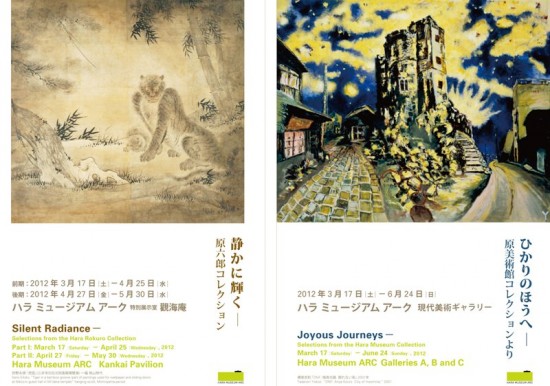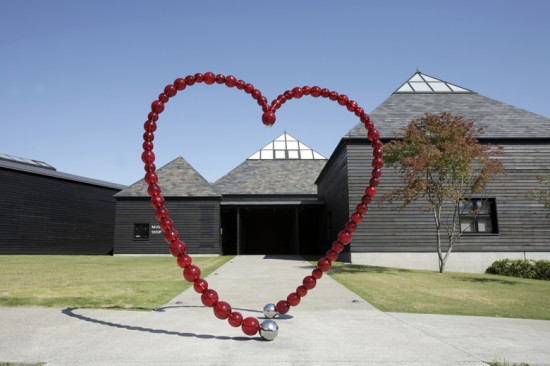From Hara Museum ARC, Gunma

From the left: Kano Eitoku Tiger in a bamboo groove (part of paintings used for wallpaper and sliding doors at Nikko-in guest hall in Mi’idera temple) hanging scroll, Momoyama period /Tadanori Yokoo DNF: Anya Kouro City of Insomnia 2001
Joyous Journeys – Selections from the Hara Museum Collection
Saturday, March 17 – Sunday, June 24, 2012 Galleries A, B and C
The Ikaho region where Hara Museum ARC is situated has long flourished as one of Japan’s preeminent tourist spots. Praises for Ikaho can be found as far back as the ancient anthology of poetry, the Manyoshu. During the Edo period, it was admired for the therapeutic value of its hot springs, for its views of Mt. Haruna and for visits to Mizusawa Temple on New Year’s Day. Nowadays, the Japanese word ″tourism″ generally means travel for the purpose of enjoyment. But digging into its roots, we find the same expression in Chinese classics that literally means ″to see the light of the country.″ Could this light be the indescribable glow that emanates from the sight of people living happy lives?
For this exhibition, we have thus chosen art from the Hara Museum Collection that exemplifies this interpretation — art that is filled with the joy, comfort and brilliance of life. We hope you will come on a ″tour″ of the museum and be bathed in the joyous glow of its art.
Featured artists: Toshikatsu Endo/Yayoi Kusama/Hiroe Saeki/Tokihiro Sato/Hiroshi Sugimoto/Tabaimo/Kohei Nawa/Hiroharu Mori/Tadanori Yokoo/Cao Fei/George Rickey/Sigmar Polke/Piotr Kowalski and others
Silent Radiance–Selections from the Hara Rokuro Collection
Part I: Saturday, March 17 – Wednesday, April 25, 2012
Part II: Friday, April 27 – Wednesday, May 30, 2012
Kankai Pavilion
The masterworks of Far Eastern art that the Meiji-era businessman Hara Rokuro collected over the course of his life comprise the present-day Hara Rokuro Collection, with Japanese paintings of the pre-modern era as its core. This exhibition showcases a number of exquisite paintings and calligraphic works from the collection noted for their elegant radiance. Among these are: Kano Eitoku’s Tiger in a bamboo grove from a group of paintings that were originally partition or interior wall paintings at the Nikko-in Mi’idera temple, which comprises the heart of the Hara Rokuro Collection; Sesson’s Portrait of Lie Zi, which shows a man floating in the air as he plays a flute, the flowing folds of his robe exquisitely depicted by the artist’s unique brushwork; and Reiso-dai, a rare collection of model calligraphy texts.
By displaying selected works of contemporary art together with these traditional masterpieces, the viewer is presented with an aesthetic world interweaving expressions and forms that transcend time and place. We hope you will come and enjoy the beauty of the collections from a variety of perspectives.
Featured works (selected)
Traditional Art: 【Part I】 Kano Eitoku Tiger in a bamboo groove (part of paintings used for wallpaper and sliding doors at Nikko-in guest hall in Mi’idera temple) hanging scroll, Momoyama period/Kano school Scene based on an old Chinese anecdote ‘Assembly at the Orchid Pavilion’(part of paintings used for wallpaper and sliding doors at Nikko-in guest hall in Mi’idera temple) four hanging scrolls, Momoyama – Edo period/Book of model handwriting, called ‘Reiso-dai‘ Nara – Muromachi period, and others
【Part II】 Sesson Portrait of Lie Zi Muromachi period/Kano Eitoku Tiger in a bamboo groove (part of paintings used for wallpaper and sliding doors at Nikko-in guest hall in Mi’idera temple) four hanging scrolls, Momoyama period/Kano Tan’yu Avalokitesvara appearing from the clam Edo period/Shen Nanping A pair of cranes and an old pine tree Qing dynasty, and others
Contemporary Art: Anish Kapoor void 1992/Hitomi Uchikura Lumiēre 2007/Izumi Kato Untitled 2008, and others
Place: Hara Museum ARC (2855-1, Kanai, Shibukawa-shi, Gunma 377-0027) Tel: 0279-24-6585
Organized by: Hara Museum of Contemporary Art
Hours: 9:30 am – 4:30 pm *Last entry 30 minutes before closing
Closed: Thursdays (except March 22, 29 and May 3) *Closed temporarily in the event of severe weather.
Admission: General (over 12) 1,000 yen; Children (over 3) 500 yen; 10% discount for a group of 20 or more.
**Children must be accompanied by an adult ***Combination ticket for Hara Museum ARC and Ikaho Green Bokujo ranch: General 1,800 yen; Children 900 yen (except April 29, May 3 – 6)
Hara Museum ARC is now participating in MuPon (museum discount ticket system using iPhone application)! http://www.tokyoartbeat.com/apps/mupon
Visit Hara Museum ARC and Hara Museum Twitter (in Japanese only) (account name: @HaraMuseumARC @haramuseum)
http://twitter.com/HaraMuseumARC
http://twitter.com/haramuseum
http://www.haramuseum.or.jp (museum website)
http://mobile.haramuseum.or.jp (mobile site)
Enjoying the Cherry Blossoms and Outdoor Sculptural Installations
Scattered on the grounds of Hara Museum ARC are a number of unique artworks by artists on the cutting edge of the art scene, including Kokoro (2009) by Jean-Michel Othoniel, a sculptural piece consisting of linked red Murano-glass globes, and A Fragmentary Anatomy of Every Setting Sun (2010) by the Korean artist Lee Bul, which is encased in a metallic case with its image reflected endlessly into infinity. In the spring, these works compete for your attention with the great variety of cherry blossoms that come into glorious bloom (from mid-April to the beginning of May).

Jean-Michel Othoniel,Kokoro,2009
——————————————————————————————————
ACCESS
Getting There: By train: Take the Joetsu Shinkansen to Takasaki, change to the Joestu Line, and disembark at Shibukawa. From Shibukawa, ARC is 10 minutes away by taxi or 15 minutes by bus (take the Ikaho Onsen bus to ″Green Bokujo Mae″). By car: 8 kilometers (about 15 minutes) from the Kan-etsu Expressway Shibukawa Ikaho Interchange (in the direction of Ikaho Onsen).
By Train
By JR Joetsu・Nagano Shinkansen
Recommended timetable
・08:04Depart Tokyo Station→09:05Arrive at Takasaki Station/ 09:17Depart Takasaki Satation→09:42Arrive at Shibukawa Station
・11:44Depart Tokyo Station→12:33Arrive at Takasaki Station/ 12:50 Depart Takasaki Satation→13:14 Arrive at Shibukawa Station
・12:24 Depart Tokyo Station→13:14 Arrive at Takasaki Station/ 13:31 Depart Takasaki Satation→13:58Arrive at Shibukawa Station
By JR Joetsu Limited Express Kusatsu
・ 9:00 Depart Ueno Station→10:39Arrive at Shibukawa Station (No.31 ; operates only on Saturdays, Sundays and holidays)
・10:00 Depart Ueno Station→11:44 Arrive at Shibukawa Station (No.1)
・12:00 Depart Ueno Station→13:42 Arrive at Shibukawa Station (No. 3)
From Shibukawa Station, take the Kan-etsu Kotsu Bus and get off at the station “Green Bokujo Mae.” http://www.kan-etsu.net/r-bus/timetable/shibu-ikaho-1.htm (in Japanese only). ARC is about 7 minute walk from the bus station.
By Car
Take the Kan-etsu Expressway to Shibukawa Ikaho Interchange. Go in the direction of Ikaho Onsen for 8 km (about 15 min.) .
Highway information:
E-NEXCO Drive Plaza http://www.driveplaza.com/ (in Japanese only)
